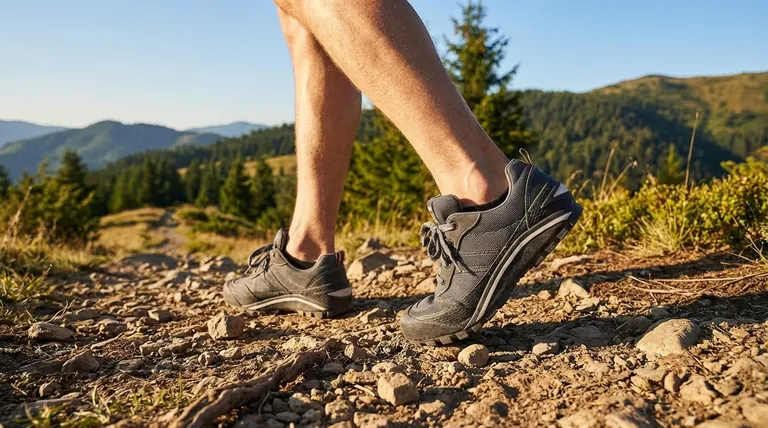At their core, low-cut hiking shoes offer a distinct trade-off: you gain significant lightness and flexibility at the direct expense of ankle support and overall protection. They excel in specific conditions but become a liability when those conditions change, making the choice dependent entirely on the nature of your hike.
The decision between low-cut shoes and high-cut boots is not about which is "better," but about correctly matching your footwear to the specific demands of the terrain, your pack weight, and the duration of your hike.

The Case for Low-Cut Hiking Shoes
For many hikers and specific types of trails, the advantages of a low-cut design are compelling. They prioritize comfort and agility for fast-and-light adventures.
Unmatched Lightness and Flexibility
The most immediate benefit is a significant reduction in weight compared to traditional boots. This translates to less energy expended with every step, reducing fatigue over a long day.
Their flexible construction requires little to no break-in period, meaning they are comfortable straight out of the box.
Enhanced Agility and Trail Feel
A flexible sole and low-cut design allow your foot to move more naturally. This can improve your balance and give you a better feel for the ground beneath you on predictable, well-groomed trails.
Superior Breathability
Low-cut shoes are typically made with lighter, more breathable materials than heavy-duty boots. This construction allows heat and moisture to escape, keeping your feet cooler and drier, which is especially valuable during summer hikes.
The Critical Downsides: Where Low-Cuts Fall Short
The very features that make low-cut shoes light and agile also create their most significant weaknesses. These limitations are crucial to understand before tackling demanding terrain.
The Absence of Ankle Support
This is the single most important disadvantage. The low cuff offers virtually no protection against rolling or twisting an ankle, a common injury on rocky, uneven, or unstable ground.
This lack of support makes them a riskier choice for inexperienced hikers or anyone venturing onto technical trails.
Reduced Protection from the Elements
Without a high cuff, your ankles are exposed to scrapes from rocks, brushes with thorny plants, and easier entry for trail debris like pebbles and sand.
They also provide less protection from water. Puddles or stream crossings that a boot could handle will quickly lead to wet feet in a low-cut shoe.
Limited Suitability for Heavy Loads
When you carry a heavy backpack, your center of gravity is raised, and more stress is placed on your feet and ankles.
Low-cut shoes lack the rigid structure and support needed to stabilize your foot under this extra weight, particularly during long descents. This can lead to foot fatigue and an increased risk of injury.
Understanding the Trade-offs: Shoe vs. Boot
Choosing the right footwear requires a clear-eyed assessment of the fundamental compromises between a lightweight shoe and a traditional hiking boot.
Weight vs. Support
This is the primary trade-off. Hiking shoes prioritize low weight for mobility and energy conservation. Hiking boots intentionally add weight and rigidity to provide maximum ankle support and foot protection.
Durability and Longevity
While more durable than a trail running shoe, a hiking shoe is generally less robust than a full boot. Hiking boots are built with tougher materials in the uppers and soles, designed to withstand thousands of miles of rugged use.
Immediate Comfort vs. Long-Term Fit
Hiking shoes are flexible and comfortable from the first wear. In contrast, stiffer hiking boots often require a break-in period for the material to mold to your foot, but this process results in a highly supportive, customized fit for demanding treks.
Making the Right Choice for Your Hike
Your decision should be guided by a realistic assessment of where and how you plan to hike.
- If your primary focus is day hiking on well-maintained trails with a light pack: A low-cut hiking shoe is an excellent choice for its comfort, breathability, and low weight.
- If your primary focus is multi-day backpacking with a heavy pack: The ankle support, stability, and durability of a mid- or high-cut hiking boot are non-negotiable for safety and comfort.
- If your primary focus is hiking on rough, rocky, or unpredictable terrain: Prioritize the injury-prevention and protection offered by the robust ankle support of a hiking boot, regardless of your pack weight.
Ultimately, the best footwear is the one that correctly matches the demands of your adventure.
Summary Table:
| Feature | Low-Cut Hiking Shoe | Hiking Boot |
|---|---|---|
| Ankle Support | Minimal | Maximum |
| Weight | Light | Heavy |
| Best For | Day hikes, light packs | Multi-day trips, heavy packs |
| Terrain | Well-maintained trails | Rough, uneven terrain |
| Break-in Period | Minimal | Often Required |
Need the Perfect Footwear for Your Hiking Business?
As a large-scale manufacturer, 3515 produces a comprehensive range of footwear for distributors, brand owners, and bulk clients. Whether your customers need agile low-cut shoes for trail running or durable high-cut boots for backpacking, our production capabilities encompass all types of shoes and boots to meet your specific market demands.
Contact 3515 today to discuss your manufacturing needs and get a quote!
Visual Guide

Related Products
- Durable Rubber Sole Outdoor Shoes Wholesale & Custom Manufacturing
- Safety Footwear Wholesale Manufacturer for Custom OEM/ODM Production
- Durable Waterproof Rain Boots | Custom Manufacturer for Wholesale & Brands
- Durable Rubber-Soled Utility Shoes for Wholesale & Custom Brand Manufacturing
- Premium Suede Sport Safety Shoes for Wholesale & Bulk Orders
People Also Ask
- Why are rubber-soled shoes considered multi-weather footwear? Unlock All-Season Traction & Protection
- What are the main applications of vulcanized rubber? Unlock Durability for Tires, Footwear & More
- What should be considered when choosing hiking boots for snake protection? Prioritize Fit & Materials for Safety
- Why are vulcanized soles popular in urban fashion? Discover the Legacy of Authentic Street Style
- What were traditional shoe soles made from before rubber? The History of Leather Soles



















